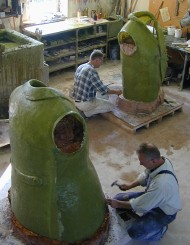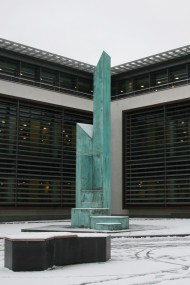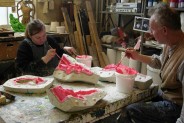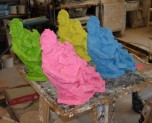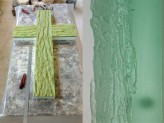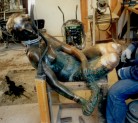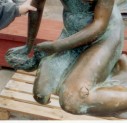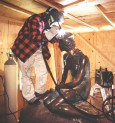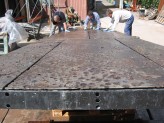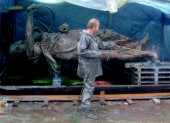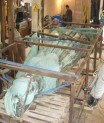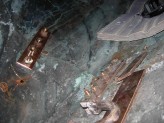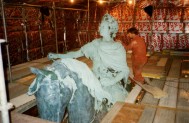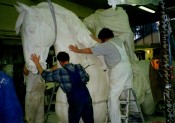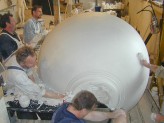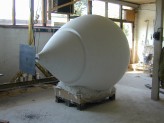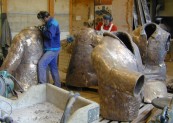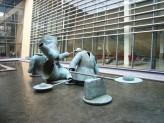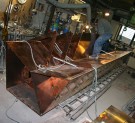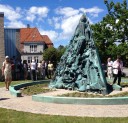When a sculptor has formed a sculpture ready for casting, it is transported to Broncestøberiet, where the craftsmen continue the work process:
A mould must be made of the sculpture/model. Then a wax replica must be made, which is subsequently annealed from its surrounding mould material, before molten metal alloy is cast into the mould, and the resulting cooled sculpture can be chased and patinated.
Sculptures are cast as whole or in segments. Each single segment can measure up to 230 x 150 x 100 cm in volume, and with our melting capacity of 800 kg. bronze, we can cast segments with a surface area of up to 16 m2 in a single session.
The following describes the whole process of making a model in non-inflammable material
The negative mould of the model is usually manufactured by coating the whole surface with silicone in a thickness of at least 5 mm. Outside the silicone mould, a plaster casing is made in sections, strengthened with canvas and iron.
Subsequently the sections of the plaster casing and the silicone “imprint” are removed from the model. These are re-assembled without the model, and a negative mould of the artwork is now ready.
The assembled negative mould is then filled with 70°C molten wax. Due to the difference in temperature between the mould and the wax, the wax closest to the mould hardens, and after ca. 1 minute, the hot wax is poured out, leaving a 3-5 mm wax crust inside the mould. A precise surface replica of the original model. The interior of the wax replica is then filled out with a support core consisting of crushed, fired clay and plaster of Paris mixed with water.
The negative mould is removed, and the wax model replica is ready for the next stages.
Core support rods are hammered through the wax model, which is additionally affixed with a system of wax casting channels and wax air ducts.
The wax model is then covered with a thin layer consisting of finely crushed fired clay and wet plaster, after which a case is built up around the model. This in turn is filled with mould material. When this material has hardened, the case is removed and the form is fired in an annealing oven at 600 °C for up to 14 days, depending on the size and form . The annealing process ensures that all water has evaporated from the form material and, significantly, that the wax has burned away, leaving a vacant space in the mould.
Following this stage, the mould is extremely delicate, and is therefore reinforced with boards and iron rods, before casting begins. The bronze, or other molten metal alloy, is poured into the mould: Into the space vacated by the wax. When the bronze has cooled, the mould material is broken away, the core material is bored out, and the core rods, casting channels and air ducts, now of bronze, are sawn off.
Finally, the holes and marks left from the removed core support rods and casting channels are welded and chased. The sections of larger sculptures are welded together and chased, rendering the welding seams invisible in relation to the surface appearance of the sculpture.
Patination is a treatment of the surface, of the sculpture, whereby the metal is coloured. This is achieved by means of various chemicals, which are applied either cold or hot.
The advantage of using the Cire-perdue method is that we can not only cast very complex sculptures, while retaining the finest detail of the surface (edges, lines, smudges, fingerprints, and so on), but also sculptures of considerable size, still with a freight thickness as low as 2-5 mm.
A way of achieving even more authenticity in the model is to cast the model directly. A case is built around the more or less inflammable object. This in turn is filled with mould material. And the object is burnt out directly instead of the wax-model.
